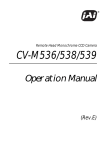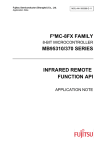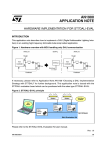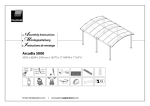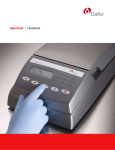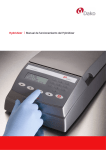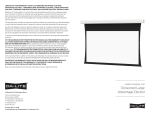Download JAI CV-M300 Security Camera User Manual
Transcript
Industrial Monochrome CCD Camera CV-M300 Operation Manual (Rev.E) CV-M300 DECLARATION OF CONFORMITY AS DEFINED BY THE COUNCIL DIRECTIVE 89/336/EEC EMC (ELECTROMAGNETIC COMPATIBILITY) WE HEREWITH DECLARE THAT THIS PRODUCT COMPLIES WITH THE FOLLOWING PROVISIONS APPLYING TO IT. EN-50081-1 EN-50082-1 CV-M300 Table of Contents Table of Contents ....................................................................................................................................... 2 1. General ................................................................................................................................................ 3 2. Standard Composition ......................................................................................................................... 3 3. Main Features ..................................................................................................................................... 3 4. Locations and Functions ..................................................................................................................... 4 5. Pin Assignment ................................................................................................................................... 5 5.1. 12-pin Multi-connector (DC-IN/SYNC.) ...................................................................................... 5 5.2. 6-pin Multi-connector (TRIGGER) .............................................................................................. 5 6. Functions and Operations ................................................................................................................... 6 6.1. Input/Output of HD/VD Signal ................................................................................................... 6 6.1.1. Input of External HD/VD Signal ..................................................................................... 6 6.1.2. Output of Internal HD/VD Signal ................................................................................... 6 6.2. Normal Shutter Mode ................................................................................................................ 6 6.3. External Trigger Mode ............................................................................................................... 6 6.3.1. Edge Pre-select Mode ................................................................................................... 6 6.3.2. Pulse Width Control Mode ............................................................................................. 8 6.3.3. Start/Stop Trigger Mode .............................................................................................. 10 6.3.4. Long Time Exposure Mode ........................................................................................... 12 7. Mode Setting ...................................................................................................................................... 14 7.1.1. SW1 Switch on the Rear Panel ...................................................................................... 14 7.1.2. Table for SW 1 Setting ................................................................................................... 14 7.1.3. Table for Shutter Time .................................................................................................. 14 7.1.4. Ext. Trigger Shutter Mode ............................................................................................. 15 7.1.5. Trigger Select ............................................................................................................... 15 7.1.6. CCD Accumulation ........................................................................................................ 15 7.1.7. Scanning System .......................................................................................................... 15 7.1.8. Gamma Correction ....................................................................................................... 15 7.1.9. Gain Control ................................................................................................................. 15 7.2. SW2 on PK8057 Board .............................................................................................................. 15 7.3. Jumper Settings ........................................................................................................................ 16 7.3.1. Jumper on PK8041 Board .............................................................................................. 16 7.3.2. Jumper on PK8042 Board .............................................................................................. 16 7.3.3. Pixel Clock Output ........................................................................................................ 16 7.4. Location of SW2 and Jumpers ................................................................................................... 17 7.4.1. Board PK8041 Side A .................................................................................................... 17 7.4.2. Board PK8042 Side A .................................................................................................... 17 8. Adjustment of Video Signal Output Level .......................................................................................... 18 9. External Appearance .......................................................................................................................... 19 10. Specifications .................................................................................................................................... 20 10.1. Spectral Sensitivity .................................................................................................................. 20 11. Appendix ............................................................................................................................................ 21 11.1. Precautions .............................................................................................................................. 21 11.2. Typical CCD Characteristics ...................................................................................................... 21 12. User’s Record .................................................................................................................................... 22 -2- CV-M300 1. General The CV-M300 is a monochrome 2/3" CCD camera designed for automated imaging applications featuring high performance and unique functions within a uniform and compact housing. The high-speed shutter function and asynchronous random trigger function allow the camera to capture high quality images of fast moving objects. It is suitable for industrial applications such as on-line inspection and measurements. In addition to conventional random trigger modes, the newly added pulse width control shutter mode makes it possible control the accumulation time by the trigger pulse width. 2. Standard Composition The standard camera composition consists of the camera main body, tripod mount plate and operation manual. 3. Main Features • • • • • • • • • • • • • 2/3" interline transfer CCD sensor with 768 (h) x 494 (v) pixels for EIA and 752 (h) x 582 (v) pixels for CCIR. High horizontal resolution. 570 TV lines for EIA, 560 TV lines for CCIR. Excellent S/N. Better than 59dB. High sensitivity. Minimum 0.05 lx illumination on CCD sensor. Improved smear performance and higher dynamic range. Random trigger modes with edge pre-select shutter, start/stop shutter and pulse width control shutter. Random trigger shutter up to 1/10,000 sec. Long-time exposure mode from a single field to several seconds. WEN -, EEN - and pixel clock output to support further advanced image capturing. Internal or external HD/VD synchronization. Easy shutter and functions mode setting from rear panel. Lens mount for C-mount lens. The camera features a robust package, lightweight and compact size. -3- CV-M300 4. Locations and Functions 1 2 3 4 5 6 7 8 9 2/3" interline transfer CCD sensor. Lens mount of C-mount type. *1) BNC connector for video output. Switch block SW1 for shutter speed and function modes setting. 6-pin multi connector for WEN and EEN output external trigger input. 12-pin multi connector for +12V DC power, video output and HD/VD input/output. GAIN potentiometer for manual gain adjustment. Screw holes for Tripod mount plate. Tripod mount plate to place the camera on tripod. Note: *1) Rear protrusion on C-mount lens must be less than 10.0 mm (0.4 inches approx.). When IR-cut filter is used, it must be less than 7.0 mm (0.28 inches approx.). The IR cut filter is placed in the C-mount thread. The C-mount 25 mm IR cut filter must be ordered separately. -4- CV-M300 5. Pin Assignment 5.1. 12-pin Multi-connector (DC-IN/SYNC.) Type: HR10A-10R-12PB-01 (Hirose) male Seen from rear. Pin no. Signal Remarks 1 GND 2 +12 V DC input 3 GND 4 Video output 5 GND 6 HD input/output HD in as factory setting. *1) VD in as factory setting. *1) *2) 7 VD input/output 8 GND 9 NC 10 GND 11 +12 V DC input 12 GND Parallel with the BNC video output. Avoid double termination. NC as factory setting. Pixel clock output. *1) Notes: *1) Signals on pin no. 6, 7 and 9 can be changed by jumper setting. See “7.3. Jumper Settings” for more information. *2) In Edge Pre-select and Pulse Width Control mode do not input ext. VD signal. 5.2. 6-pin Multi-connector (TRIGGER) Type: HR10A-7R-6PB (Hirose) male Seen from rear. Pin no. Signal Remarks 1 NC 2 EEN output 3 GND 4 NC 5 Ext. Trig input * Note 6 WEN output * Note * Note * Notes: The functions available on the 6-pin multi-connector are not effective in long time exposure mode. -5- CV-M300 6. Functions and Operations 6.1. Input/Output of HD/VD Signal 6.1.1. Input of External HD/VD Signal As factory setting the camera can be synchronized by external HD/VD signals. The signal level must be 4.0 Vp-p ± 2.0V at the input with the 75 Ohm termination ON. To change to non-terminated input, see instructions in “7. Mode Setting”. If no ext. HD is connected, the camera will switch to the internal X-tal controlled HD. If no ext. VD is connected, the camera will continue with its internal VD. 6.1.2. Output of Internal HD/VD Signal The internal HD/VD output is 4.0 Vp-p from a 75 Ohm source. To select this mode, see instructions in “7. Mode Setting”. 6.2. Normal Shutter Mode When trigger select SW1-4 is OFF, the camera is in normal mode. The SW1-1, SW1-2 and SW1-3 are for selecting the shutter speed. The range is from OFF to 1/10,000 second in 8 steps. The camera is running continuously with an exposure as the selected shutter time. The shutter time setting is shown in “7.1.3. Table for Shutter Time”. 6.3. External Trigger Mode External trigger mode of CV-M300 allows 4 different driving modes, as follow. 1 Edge pre-select mode. (Asynchronous reset and exposure start by an ext. trigger) 2 Pulse width control mode. (Exposure control by the low period of the ext. trigger) 3 Start/Stop trigger mode. (Exposure start by the ext. trigger and end by the ext. VD signal) 4 Long time exposure mode. (Exposure control by the interval of the ext. VD signal) The trigger input is AC coupled, so there is a maximum pulse width for the trigger pulse of around 60 msec. The signal level must be 4.0 Vp-p ± 2.0V. The trigger input has a fixed resistance larger than 1 kOhm and cannot be terminated with 75 Ohm by internal settings. The following describes the details of each trigger mode. 6.3.1. Edge Pre-select Mode The edge pre-select mode operation will only work in non-interlaced and field accumulation mode. The CV-M300 starts the exposure (= accumulation of photoelectric charge) at the first HD pulse after the falling edge of the ext. trigger pulse. The exposure ends after the time set by the 3 shutter switches SW1-1 to SW1-3. The range is 8 steps from OFF (1/60 or 1/50) to 1/10,000 second. In this mode, the EEN (Exposure ENable) pulse and WEN (Write ENable) pulses are generated and output from the camera. The EEN pulse indicates the exposure time and can be used to control the illumination such as strobe light. The EEN pulse is output from pin 2 of the 6-pin multi connector. The signal level is 4.0 Vp-p from a 75 Ohm source. The WEN pulse indicates the time period of the effective video signal output, and is useful for the timing and interfacing of external devices such as frame grabbers. The WEN pulse is output from pin 6 of the 6pin multi connector. The signal level is 4.0 Vp-p from a 75 Ohm source. The video must be read out before a new trigger can be applied. The interval between trigger pulses must be longer than the time for 1 field + the shutter time. It is the limit for the field rate. -6- CV-M300 To use this mode Set: SW1-4 to ON for ext. trigger shutter SW1-5 to OFF for field accumulation SW1-6 to ON for non-interlaced SW1-1, 2 and 3 to shutter speed Input: Ext. trigger to pin 5 on 6 pin multi connector. Ext. HD to pin 6 on 12-pin multi connector. (If used). 75 Ohm termination is done with SW2-1 (HD) on PK8041 board. Refer to Timing Chart and Cautions on next page. Detailed switch and jumper setting is described in “7. Mode Setting”. For connections see “5. Pin Assignment”. Cautions in the Edge Pre-select Mode. 1. Edge pre-select mode is effective only in non-interlaced, field accumulation mode. 2. The exposure start may delay up to 1H max., when the falling edge of ext. trigger pulse is not synchronized with the falling edge of ext. HD signal. To avoid this 1H delay and jitter, the falling edge of the trigger pulse should be synchronized with the HD pulse as shown below. It can be the ext. HD input or the Internal HD output. Ext.TRIGGER Ext.HD A A A A A=4.4 µS 3. The ext. trigger input is TTL level. The duration should be more than 1 H negative going. >64 µsec. and < 60 msec. The input is AC coupled. 4. If the ext. HD input is TTL level, set SW2-1 OFF for non-terminated. See “7.2 SW2 on PK8041 Board”. EIA (Non-interlaced / Field accumulation mode) Edge pre-select mode (for non-interlace only) EIA : 1H = 63.5µs TRIG 1H >1H TRIG in EXT HD INT HD INT VD 1.5H 9H 9H 1H 1.5H 9H EEN Exposure time 12.5H Exposure time 0.5H WEN 10.5H 2H 9H CCD out Effective pixels No.10 to 251 Video out 20H Blanking 242H Effective video -7- 20H Blanking 0.5H CV-M300 CCIR (Non-interlaced / Field accumulation mode) Edge pre-select mode (for non-interlace only) CCIR : 1H = 64µs TRIG 1H >1H TRIG in EXT HD INT HD INT VD 1.5H 7.5H 7.5H 6.5H 1.5H 7.5H EEN Exposure time 16.5H Exposure time 0.5H 0.5H WEN 9H 7.5H 10H 14H CCD out Effective pixels No.10 to 251 Video out 25H 287H 25H Blanking Effective video Blanking 6.3.2. Pulse Width Control Mode The pulse width control mode will only work in non-interlaced field accumulation mode. The exposure is controlled by the low period of the ext. trigger pulse. The CV-M300 starts the exposure at the first HD pulse after the falling edge of the ext. trigger pulse. The exposure ends at the first HD pulse after the rising edge of the ext. trigger. The Shutter can be controlled to be within the range from >1H (>64 usec.) to <60 msec. The AC coupling causes the upper limit. EEN (Exposure ENable) pulse and WEN (Write ENable) pulses are generated and output from the camera. The EEN pulse indicates the exposure time. The EEN pulse is output from pin 2 of the 6-pin multi connector. The signal level is 4.0 Vp-p from a 75 Ohm source. The WEN pulse indicates the time period of the effective video signal output and is useful for the timing and interfacing of external devices such as frame grabbers. The WEN pulse is output from pin 6 of the 6pin multi connector. The signal level is 4.0 Vp-p from a 75 Ohm source The video must be read out before a new trigger can be applied. The interval between trigger pulses must be longer than the time for 1 field + the shutter time. It is the limit for the field rate. To use this mode Set: SW1-1, 2 and 3 to OFF SW1-4 to ON for ext. trigger shutter SW1-5 to OFF for field accumulation SW1-6 to ON for non-interlaced JP14 on PK8042 to OPEN Input: Ext. trigger to pin 5 on 6-pin multi connector. Ext. HD to pin 6 on 12-pin multi connector. (If used). 75 Ohm termination is done with SW2-1 (HD) on PK8041 board. Refer to Timing Chart and Cautions on next page. Detailed switch and jumper setting is described in “7. Mode Setting”. For connections see “5. Pin Assignment”. -8- CV-M300 Cautions in the Pulse Width Control Mode. 1. Pulse width control mode is effective only in non-interlaced field accumulation mode. 2. The exposure start may be delayed up to 1H max., when the falling edge of ext. trigger pulse is not synchronized with the falling edge of ext. HD signal. To avoid this 1H jitter and delay, the falling edge of the ext. trigger pulse should be synchronized within 4.4 usec. to the HD pulse. It can be the ext. HD in or the Internal HD out. See cautions in Edge Pre-select Mode page 7. 3. The voltage level of the ext. trigger has to be 4.0 Vp-p ± 2.0 V. The duration of the negative going trigger signal has to be longer than 1H = 64 µsec. and shorter than 60 msec. The input signal is AC coupled. EIA (Non-interlaced / Field accumulation mode) Pulse width control mode (for non-interlace only) EIA : 1H = 63.5µs TRIG >1H 1H TRIG in EXT HD INT HD INT VD 1.5H 9H 1H 1.5H 9H EEN Exposure time 12.5H Exposure time 0.5H 0.5H WEN 2H 9H 10H CCD out Effective pixels No.10 to 251 Video out 20H 242H Blanking 20H Effective video Blanking CCIR (Non-interlaced / Field accumulation mode) Pulse width control mode (for non-interlace only) CCIR : 1H = 64µs TRIG >1H 1H TRIG in EXT HD INT HD INT VD 1.5H 7.5H 7.5H 6.5H 1.5H 7.5H EEN Exposure time 16.5H Exposure time 0.5H WEN 9H 7.5H 10H 14H CCD out Effective pixels No.10 to 251 Video out 25H 287H 25H Blanking Effective video Blanking -9- 0.5H CV-M300 6.3.3. Start/Stop Trigger Mode The Start /Stop trigger will work in 3 modes: 1. Interlaced with frame accumulation. 2. Interlaced with field accumulation. 3. Non-interlaced with field accumulation. The exposure time is controlled by the interval between the ext. trigger pulse and the ext. VD signal. The exposure starts at the first HD pulse after the falling edge of the ext. trigger, and stops at the rising edge of the VD pulse. The range can be within 1/77 to 1/10,000 sec. The Start/Stop mode is a continuous mode where the VD signal must be given continuously. It is not possible to input ext. VD randomly. For the interlaced modes 2 ext. trigger pulses should be applied for each frame. It is one for each field. In this way it is possible to have different exposure time for the 2 fields within an interlaced frame. The difference between interlaced frame accumulation or field accumulation can be explained as follow. Both modes have 2 fields output in an interlaced frame. With frame accumulation the contents in the ODD and EVEN sync. fields will come from sensing field 1 and 2 on the CCD sensor. With field accumulation both ODD and EVEN sync. field will contain the signal from sensing field 1 and 2 added together. Non-interlaced with field accumulation needs only 1 trigger pulse for each field. To use this mode Set: SW1-1, 2 and 3 to ON for 1/10,000 sec. SW1-4 to OFF for normal shutter. SW1-5 to ON for frame accumulation or OFF for field accumulation. SW1-6 to OFF for 2:1 interlaced or ON for non-interlaced. Jumper JP14 on the PK8042board SHORT. Jumper JP7, JP11, JP12 on the PK8041 board SHORT. Jumper JP6, JP8, JP9, JP10 on the PK8041 board OPEN. Input: Ext. trigger to pin 5 on 6 pin multi connector. (Cannot be 75 Ohm terminated.) Ext. VD to pin 7 on 12 pin multi connector. Ext. HD to pin 6 on 12 pin multi connector. (If used). HD/VD 75 Ohm termination is done with SW2-1 and SW2-2 on PK8041 board. Refer to Timing Chart and Cautions on next page. Detailed switch and jumper setting is described in “7. Mode Setting”. For connections see “5. Pin Assignment”. - 10 - CV-M300 Cautions in the Start/Stop Trigger Mode. 1. The input of ext. VD signal must be given continuously to synchronize with int. VD signal. It is not possible to input ext. VD signal randomly. 2. The exposure start may delay up to 1H max., when the falling edge of ext. trigger pulse is not synchronized with the falling edge of ext. HD signal. To avoid this 1H jitter and delay, the falling edge of the ext. trigger pulse should be synchronized within 4.4 usec. to the HD pulse. It can be the ext. HD input or the internal HD output. Shown under cautions in Edge Pre-select Mode page 7. 3. If the ext. VD input and ext. HD input are from a source with TTL level, set SW2-1 and SW2-2 on PK8041 board OFF for non-terminated. SW2-1 for ext. HD signal, SW2-2 for ext. VD signal. See “7.2 SW2 on PK8041 Board”. 4. Each scanning mode requires the following number of external trigger pulses: - 2:1 interlaced: 2 external trigger pulses per frame - Non-interlaced: 1 external trigger pulse per field a) Interlaced mode (Frame accumulation mode) Ext.Trg. 1 2 Ext. VD Exposure t1 t1 time Video b) 2:1 Interlaced mode (Field accumulation mode) Ext.Trg. 1 2 Ext. VD Exposure time Video c) Non-interlace moded (Field accumulation mode) Ext.Trg. 1 Ext. VD Exposure time Video - 11 - CV-M300 6.3.4. Long Time Exposure Mode The Long time exposure will work in 3 modes: 1. Interlaced with field accumulation. 2. Interlaced with frame accumulation. 3. Non-interlaced with field accumulation. The exposure time is the interval between 2 ext. VD pulses sent to the camera VD input. Each ext. VD pulse will reset and restart the internal VD in the camera as for ext. HD/VD input. So the camera is synchronized to the external HD/VD supply after each VD input. An exposure starts after input of an external VD pulse, and ends after the next input of ext. VD, which again starts a new exposure. The long time exposure is a continuous process where each external VD will synchronize the camera, stop an exposure, start a new exposure and read out the previous accumulated signal as interlaced or non-interlaced fields. The exposure control can be done by feeding every Nth VD pulse from the external HD/VD supply to the camera. N is the wanted exposure time in number of fields. This is typically done in the frame grabber PC. The range for long time exposure is from 1 V (a single field) to ∞. However the dark current signal will increase by longer time, so >2 seconds are not recommended at normal ambient temperature. To use this mode: Set: SW1-1, 2 and 3 to OFF SW1-4 to OFF for normal shutter. SW1-5 to ON for frame accumulation or OFF for field accumulation. SW1-6 to OFF for 2:1 interlaced or ON for non-interlaced. Jumper JP6 on PK8041 to SHORT Input: Ext. VD pulses with the exposure interval to pin 7 on 12 pin multi connector. Ext. HD to pin 6 on 12 pin multi connector. 75 Ohm termination is done with SW2-1 and SW2-2 on PK8041 board. The timing for the external VD interval has to be as follow. (V is the time for a single field) Interlaced with field accumulation. 1 V or more Interlaced with frame accumulation. 2 V or integral number of 2V Non-interlaced with field accumulation. 2 V or more Note: The external HD/VD sync. generator, which supply the ext. VD an HD signals should follow the scanning standard for the camera setting. EIA CCIR Interlaced and field accumulation. 1 V = 262.5 H 1 V = 312.5 H Interlaced and frame accumulation. 2 V = 525.0 H 2 V = 625.0 H Non-interlaced and field accumulation. 2 V = 524.0 H 2 V = 624.0 H Refer to Timing Chart and Cautions on next page. Detailed switch and jumper setting is described in “7. Mode Setting”. For connections see 5. “Pin Assignment”. - 12 - CV-M300 Cautions in the Long Time Exposure Mode. 1. Theoretical exposure time is as follows. EIA: 1/30 sec. to ∞. CCIR: 1/25 sec. to ∞. 2. It is recommended not to use exposure >2 sec. since visible dark-current noise may occur. 3. Ext. HD signal (4.0 Vp-p ± 2.0V at 75 Ohm terminated) has to be input continuously The falling edge of Ext. HD signal and Ext. VD signal are phase-synchronized. 4. Timing of ext. VD signal in each accumulation mode has to be set, as described before. a) 2:1 Interlaced mode (Field accumulation mode) b) 2:1 Interlaced mode (Frame accumulation mode) c) Non interlaced mode (Field accumulation mode) - 13 - CV-M300 7. Mode Setting Cautions on Mode Setting. Before making any mode or jumper setting turn the power OFF. 7.1.1. SW1 Switch on the Rear Panel Factory settings for SW1 are with all 8 switches in OFF position. SW1 OFF SHUTTER TRIGGER ACCUM INTERLACE GAMMA GAIN ON 1 2 3 4 5 6 7 8 1/50 1/125 1/250 1/500 1/1000 1/2000 1/4500 1/10,000 OFF = < ON = > < < < < < < > > < > < > Normal Field Interlaced 1.0 Manual > < < < < < < < > < > > > > > > Seconds > > > > < > External trigger Frame Non-interlaced 0.45 Auto The shutter values are given for a CCIR camera having the factory settings. Shutter values for other setups and EIA cameras can be seen in table 7.1.3. 7.1.2. Table for SW 1 Setting Mode setting Switch no. Switch function OFF 1 Shutter data MSB 2 Shutter data ON For shutter speed select. Refer to shutter table 7.1.3. 3 Shutter data LSB 4 Trigger select Normal Ext. trigger 5 CCD accumulation Field accumulation Frame accumulation 6 Scanning system 2:1 interlaced Non-interlaced 7 Gamma correction Gamma = 1.0 Gamma = 0.45 8 Gain Manual gain AGC on 7.1.3. Table for Shutter Time SW1-1 SW1-2 MSB SW1-3 Shutter speed (sec.) LSB Normal shutter Ext. trigger shutter OFF OFF OFF Off EIA:1/60 (CCIR:1/50) OFF OFF ON 1/100 1/125 OFF ON OFF 1/250 OFF ON ON 1/500 ON OFF OFF 1/1000 ON OFF ON 1/2000 ON ON OFF 1/4500 ON ON ON 1/10,000 - 14 - CV-M300 Cautions on Shutter. The image can flicker when the illumination is AC powered. Highlighted parts of the image will show increasing smear at a shorter shutter time. 7.1.4. Ext. Trigger Shutter Mode When trigger select SW1-4 is ON. The camera is in ext. trigger shutter mode. The SW1-1, SW1-2 and SW13 are for selecting the shutter speed. The range is from OFF to 1/10,000 second in 8 steps. For each external trigger pulse, the camera will make an exposure with the selected shutter speed. The shutter time setting is shown in “7.1.3. Table for Shutter Time”. 7.1.5. Trigger Select SW1-4 is will select the camera operation mode. OFF is normal mode, where the camera is running continuously. ON is the ext. trigger shutter mode. Here the external trigger pulse will start the exposure. 7.1.6. CCD Accumulation SW1-5 will select the CCD accumulation mode. OFF is field accumulation. It is used for moving objects. ON is frame accumulation. It is for still objects. 7.1.7. Scanning System SW1-6 will select the scanning system. OFF is 2.1 interlaced. It will follow the EIA or CCIR standard for interlaced scanning. ON is non-interlaced. In EIA the non-interlaced output is continuous ODD field. In CCIR the non-interlaced output is continuous EVEN field. If the camera is ext. HD/VD synchronized with a non-interlaced sync, SW1-6 be in ON position. 7.1.8. Gamma Correction SW1-7 will select the gamma correction. OFF is gamma 1.0. It is linear. Recommended for machine vision and image processing. ON is gamma 0.45. It is non-linear. 7.1.9. Gain Control SW1-8 is for gain select. OFF is manual gain. Here the gain can be controlled by the GAIN potmeter on the rear panel. ON is the AGC mode. Here the gain is adjusted automatically. The AGC level can be adjusted by VR3 on PK8042 board. See “8. Adjustment of Video Signal Output Level”. 7.2. SW2 on PK8041 Board This switch is to select 75 Ohm termination or TTL for ext. HD and ext. VD. VD HD SW2-1 is for HD signal. SW2-2 is for VD signal. ON is 75 Ohm terminated. (Factory setting). OFF is TTL level. ON 1 2 OFF SW 2 - 15 - CV-M300 7.3. Jumper Settings Cautions on Jumper Setting. Before making any mode or jumper setting turn the power OFF. Jumpers for mode setting are found on the boards PK8041 & PK8042. The following modes are available with jumper setting: Input/Output Mode of HD/VD signal. (HD/VD input is factory setting) Edge Pre-select Mode. (Factory setting) Pulse Width Control Mode Start/Stop Trigger Mode Long Time Exposure Mode Set the jumpers according to the list below in 7.3.1. and 7.3.2. The jumper positions are shown in “7.4.1. Board 8041 Side A” and “7.4.2. Board 8042 Side A”. Switch SW2 on PK8041 is shown in “7.2. SW2 on PK8041 Board”. 7.3.1. Jumper on PK8042 Board HD/VD in/out Jumper JP14 Ext. Int. HD/VD HD/VD input *) output Short Short External trigger modes Edge preselect Short Pulse Start/ width stop control trigger Open Short Remarks Long time expose Short Factory set SHORT, PWC open *) Factory Setting 7.3.2. Jumper on PK8041 Board HD/VD in/out Jumper Ext. Int. HD/VD HD/VD External trigger modes Edge preselect Pulse Start/ width stop control trigger Remarks Long time expose input *) output JP6 Open Open Open Open Open Short Long time integration JP7 Short Open Short Short Short Short HD input/output JP8 Open Short Open Open Open Open HD input/output JP9 Open Open Short Short Open Open WEN output on pin 7 JP10 Open Short Open Open Open Open VD input/output JP11 Short Open Open Open Short Short VD input/output JP12 Open Open Open Open Short Open JP13 Open - - - - - SW2-1 ON OFF ON ON ON ON HD in 75 Ohm term. Factory set ON SW2-2 ON OFF ON ON ON ON VD in 75 Ohm term. Factory set ON Pixel clock out. Factory set OPEN *) Factory Setting 7.3.3. Pixel Clock Output To use pixel clock output (TTL level: 4.0 V), make the jumper JP13 on PK8041 board shorted-circuited. The jumper position is shown in “7.4.1. Board PK8041 Side A”. Pixel clock pulse will be output from pin no.9 of 12-pin multi-connector. Cautions for Pixel Clock Output. When the pixel clock is enabled, it may cause interference with external equipment if it not properly shielded. - 16 - CV-M300 7.4. Location of SW2 and Jumpers Jumpers are shorted with a 0 Ohm resistor or by a soldering between the 2 points. To remove the solder tin from a jumper position, use a special tin remover such as de-soldering wick. 7.4.1. Board PK8041 Side A JP8 JP10 JP9 SW2 JP7 JP12 JP11 JP13 JP6 7.4.2. Board PK8042 Side A JP14 - 17 - CV-M300 8. Adjustment of Video Signal Output Level When an alignment of a video output signal is required, remove the camera housing and adjust potentiometers VR3, VR4 and VR5 on the PK8042 board while measuring their levels at the video output connector. This adjustment should only be done in a setup with a standard TV test chart and controlled illumination. VR3: To adjust the gain level of AGC. (Factory setting: 700 mVp-p ± 30 mV) VR4: To adjust the white level. (Factory setting: 800 mVp-p ± 20 mV) VR5: To adjust the black level. (Factory setting: 20 mVp-p ± 5 mV) CAUTION. Do not touch these potentiometers unless you are familiar with camera adjustments. Location of VR3 to VR5 on PK8042 board is as follow. VR4 VR3 VR5 - 18 - CV-M300 9. External Appearance Unit : mm (inches) 5 50 (0.2) (1.97) 26 (1.02) 4-M3 50 20 12.7 (0.5) (0.79) 80 (3.15) 5 50 (0.2) (1.97) 26 C-MOUNT (1.02) 4-M3 5 6 (0.2) Tripod mount plate 56 (2.20) 50 (1.97) 14 (0.55) 26 (1.02) 4-ø3.5 30 (1.18) ø6 +0.1 0 40 (1.57) 40 (1.57) (1.97) 4-R2 4-M3 34 (1.33) U1/4-20 Accessory(Screws):Round-top Screws M3x5 Bzn 4pcs - 19 - CV-M300 10. Specifications Scanning system CCD sensor Sensing area Effective pixels Elements in video output Cell size Resolution (horizontal) Resolution (vertical) Sensitivity on sensor S/N ratio Video output Gamma Gain Scanning Accumulation Synchronization HD sync. input/output VD sync. input/output Trigger input Trigger input duration WEN output (write enable) EEN output (exposure enable) Pixel clock output (optional) Normal shutter Edge pre-select shutter Pulse width controlled shutter Start/stop trigger shutter CCIR 625 lines EIA 525 lines 25 frames/sec. 30 frames/sec. Monochrome 2/3" IT CCD 8.8 mm (h) x 6.6 mm (v) 752 (h) x 582 (v) 768 (h) x 494 (v) 737 (h) x 575 (v) 758 (h) x 486 (v) 11.6 (h) x 11.2 (v) µm 11.6 (h) x 13.5 (v) µm 560 TV lines 570 TV lines 575 TV lines 485 TV lines 0.05 Lux >59 dB (AGC off, Gamma 1) Composite VS signal 1.0 Vpp, 75 Ohm 0.45 – 1.0 Manual – Automatic. 0 to +15 dB by potentiometer or AGC 2:1 interlace – non-interlace Field – frame Int. X-tal. Ext HD/VD or random trigger 4V, 75 Ohm* 4V, 75 Ohm* 4V, TTL >1HD 4V, 75 Ohm 4V, 75 Ohm 4V, 75 Ohm sine Off, 1/100, 1/250, 1/500, 1/1000, 1/2000, 1/4500, 1/10,000 sec. 1/5(1/60 EIA) 0, 1/100, 1/250, 1/500, 1/1000, 1/2000, 1/4500, 1/10,000 sec. >1 H (64 usec.) to <60 msec. 1/77 sec to 1/10,000 sec. 1 field to ∞. Duration between ext. VD pulses -5°C to +45°C 20 – 80% non-condensing -25°C to 60°C/20 - 90% 12V DC ±10%. 3.6W C-mount 40 x 50 x 80 mm (HxWxD) 230 g Long time exposure Operating temperature Humidity Storage temp./humidity Power Lens mount Dimensions Mass * HD sync., VD sync./(Trigger) input or output by internal jumpers. Factory setting: HD/VD input. Inputs TTL or 75 Ohm terminated by internal DIP switch. Factory setting: 75 Ohm terminated. Note: Above specifications are subject to change without notice. 10.1. Spectral Sensitivity Relative response 1.0 0.8 0.6 0.4 0.2 0.0 400 500 600 700 800 Wave length (nm) - 20 - 900 1000 CV-M300 11. Appendix 11.1. Precautions Personnel not trained in dealing with similar electronic devices should not service this camera. The camera contains components sensitive to electrostatic discharge. The handling of these devices should follow the requirements of electrostatic sensitive components. Do not attempt to disassemble this camera. Do not expose this camera to rain or moisture. Do not face this camera towards the sun, extreme bright light or light reflecting objects. Even when this camera is not in use, put the supplied lens cap on the lens mount. Handle this camera with the maximum care. Operate this camera only from the type of power source indicated on the camera. Power off the camera during any modification such as changes of jumper and switch setting. 11.2. Typical CCD Characteristics The following effects may be observed on the video monitor screen. They do not indicate any fault of the CCD camera, but do associate with typical CCD characteristics. V. Smear Due to an excessive bright object such as electric lighting, sun or strong reflection, vertical smear may be visible on the video monitor screen. This phenomenon is related to the characteristics of the Interline Transfer System employed in the CCD. V. Aliasing When the CCD camera captures stripes, straight lines or similar sharp patterns, jagged image on the monitor may appear. Blemishes Some pixel defects can occur, but this does not have en effect on the practical operation. Patterned Noise When the CCD camera captures a dark object at high temperature or is used for long time integration, fixed pattern noise (shown as white dots) may appear on the video monitor screen. - 21 - CV-M300 12. User’s Record Camera type: CV-M300 Scanning system: EIA/CCIR Revision: (Revision E) Serial No. ................. Users Mode Settings Users Modifications This manual can be downloaded from: www.jai.com - 22 - 2700-11088E E1 0901 JAI A·S, Denmark Produktionsvej 1, 2600 Glostrup Copenhagen, Denmark Phone +45 4457 8888 Fax +45 4491 8880 www.jai.com JAI Corporation, Japan German Industry Center 1-18-2 Hakusan, Midori-ku Yokohama, Kanagawa 226-0006, Japan Phone +81 45 933 5400 Fax +81 45 931 6142 www.jai-corp.co.jp JAI America, Inc., USA Suite 450 23046 Avenida de la Carlota Laguna Hills, CA 92653 USA Phone +1 949 472 5900 Fax +1 949 472 5908 www.jai.com
























